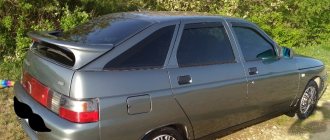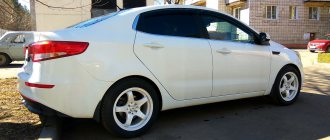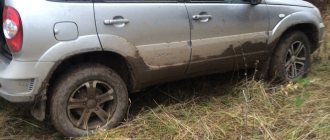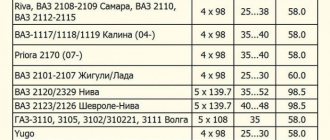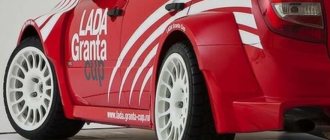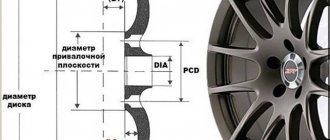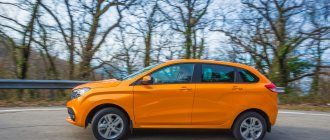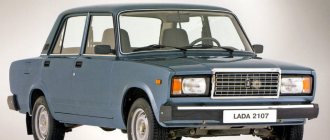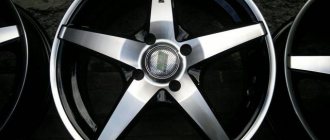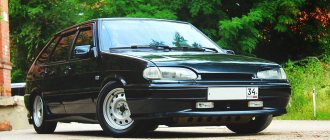Kia Rio is a city family car, classified according to the European classification as class “B”. It has a large interior and a spacious trunk, and is economical in fuel consumption, which distinguishes it very favorably from more bulky cars of class “C” and higher. Let's look at what wheel sizes can be installed on the Rio, and also give recommendations on choosing tires.
Wheel sizes of Kia Rio 4th generation
Kia Rio 2016, 4th generation Drilling - 4×100 (PCD), offset - 48 mm (ET), central hole diameter - 54.1 mm (DIA), mounting to the hub - bolt, thread - M12x1.5
| Kia Rio tire size 4 | Kia Rio 4 rim size |
| 185/65R15 | 6Jx15 |
| 195/55R16 | 6Jx16 |
Several answers to questions
In conclusion, we will try to provide simple and clear answers to the most frequently asked questions.
Question 1. What wheels are best for winter tires?
Answer: Obviously, the term “wheels” here means disks, which, as you know, can be stamped steel or light alloy. From the point of view of the driving performance of the car, it makes no difference what kind of discs you drive on.
But thrifty car owners prefer to install hardware for the winter. Firstly, the beauty of alloy wheels, stained with mud and snow, is still almost invisible.
And secondly, roads are often treated with chemicals that corrode not only the ice, but also the decorative coating on the discs. But again, this is a personal matter for everyone.
Question 2. What pressure should the Kia Rio tires have?
Answer: It depends on the engine modification and wheel size. For cars with a 1.4 liter engine at 14 and 15 radii, the manufacturer has established a standard of 2.1 MPa in the front and rear.
For 1.6L modifications with R16 195/55 wheels, you need to pump 2.2 MPa. Low profile tires R17 205/45 pump 2.7 MPa.
Question 3: Where is the year of manufacture indicated on the tire?
Answer: The date is printed on the sidewall of the tire as a four-digit number. The first pair of digits indicates the serial number of the week, and the second - the year.
Question 4. What year is the best tire to buy?
Answer: The fresher the production date of rubber, the longer it will retain its properties, and the more time the consumer has to make claims if a hidden manufacturing defect is discovered.
According to Russian standards, a passenger tire has a 5-year warranty, so it is better to buy it with the date of the current season, maximum of the previous one.
If you have a model made in Europe (the country is also indicated on the side), then the production date may be earlier. According to European standards, a passenger tire has a 10-year warranty.
Kia Rio 3 wheel sizes
3rd generation Drilling - 4×100 (PCD), offset - 36 - 52 mm (ET), central hole diameter - 54.1 mm (DIA), fastening to the hub - nut, thread - M12x1.5
| Kia Rio tire size 3 | Disk size |
| 185/65R15 | 5.5Jx15 |
| 195/55R16 | 6Jx16 |
| 205/45R17 | 6.5Jx17 |
| Non-standard sizes | |
| 185/65R15 | 6Jx15 |
General background information
Ranges of possible values for tires and wheels Kia Rio 2022.
Tires
| Diameter | 15″–17″ |
| Width (mm) | 185–205 |
| Profile (%) | 45–65 |
| The smallest size | 185/65 R15 |
| The biggest size | 205/45 R17 |
Wheel disks
| Diameter | 15″–17″ |
| Width (inches) | 6–6.5 |
| Reach (mm) | 46–49 |
| Drills | 4×100 |
Photo
Expert advice
When choosing tires for a car, you must first follow the manufacturer's instructions. Ask yourself a few questions.
- On what roads will the car be primarily used?
- Do you need increased cross-country ability?
- How much of the route will be city roads and how much will be highways?
- Will the vehicle carry heavy loads?
The answers to these and similar questions will help determine which tire parameters you need to pay special attention to.
How to choose the right wheels for Kia Rio 2022?
3 types of rims:
- Stamped (economical price category) - made from a sheet of iron by stamping on a press.
- Light alloy - manufactured by casting (more reliable than stamped ones).
- Forged (the highest quality and more expensive than the previous ones) - made from light alloys by stamping at high temperatures.
The choice depends on financial capabilities. However, it should be borne in mind that the quality of the road surface on which you have to drive every day must also be taken into account.
So, if it gets into a hole, a stamped disk will bend and will not cause harm to the tire, but a forged or cast one can cut it. There is a possibility that the cast disc may burst or crack.
It should also be noted that repairing “stamping” wheels is cheaper than repairing cast or forged wheels. But wheels with high-quality cast and forged disks kill the suspension less, because lighter and have more perfect geometry (better balanced).
The same wheels may or may not rub with tires on the same car - wheel alignment adjustment will help here.
What is the tire pressure?
It is the driver's responsibility to constantly monitor tire pressure. This will avoid standard problems associated with vehicle operation. An abnormal pressure value often causes:
- deterioration of management;
- uneven tread wear.
Often the car owner independently reduces the pressure in the wheels of his own vehicle. This reduces the load on the suspension, and the car “passes” various road irregularities an order of magnitude easier. But it is worth noting: a decrease in pressure even by 0.1 MPa leads to serious problems. The main ones include:
- increased fuel consumption;
- rapid wear of the outer tread segments;
- the car becomes less maneuverable.
An overinflated wheel causes no less problems. The central part of the cylinder begins to wear off quickly. In addition, at ambient temperatures of more than 60 degrees Celsius, the tire may simply explode. Which will lead to driving into the oncoming lane.
Tires and wheels for Kia Rio 2
2nd generation Drilling - 4×100 (PCD), offset - 39 - 46 mm (ET), central hole diameter - 54.1 mm (DIA), fastening to the hub - nut, thread - M12x1.5
| Kia Rio 2 tire size | Disk size |
| 175/70R14 | 5Jx14 |
| 185/65R14 | 5.5Jx14 |
| 195/55R15 | 5.5Jx15 |
| 205/45R16 | 6.5Jx16 |
Kia Soul bolt pattern
This compact urban crossover from Kia has been produced since 2008 to the present day. This model, produced since 2014 only with R16 wheels, has some differences in wheel parameters by year of manufacture and generation.
Kia Soul
Kia Soul of all years of production has a bolt pattern of 5×114.3. The following are installed on wheels of different model years:
- For cars produced from 2008-2014
Modifications Disk options Tire profile hub basic replacement options base replacement options 1.6 CVVT; 2.0 CVVT; 1.6CRDI; 1.6I; 1.6CRDI; 1.6 GDI 67,1 6Jx15 5/114.3 ET 44 6.5Jx16 5/114.3 ET 51 7Jx18 5/114.3 ET 54 195/65 R15 205/55 R16 225/45 R18 2.0I 67,1 6.5Jx16 5/114.3 ET 51 7Jx18 5/114.3 ET 54 205/55 R16 225/45 R18
- For cars produced in 2014-2019
Modifications Disk options Tire profile hub basic replacement options base replacement options 1.6CRDI; 1.6 GDI; 1.6 MPI; 2.0 GDI 67,1 6.5Jx16 5/114.3 ET 47 6.5Jx17 5/114.3 ET 51 7.5Jx18 5/114.3 ET 55 205/60 R16 215/55 R17 235/45 R18 EV 67,1 6.5Jx16 5/114.3 ET 47 No options 205/60 R16 No options
Drilling Kia Soul
In other words, different wheels were used in different generations. This information can be clarified in the service book or technical documents of the car. When changing wheels, rims and tires, be sure to check these numbers.
The wheel hubs of different Kia models in different years of production differ in bolt pattern sizes. It is necessary to change tires, wheels and wheels on a Kia based on these data.
Wheel and tire sizes for Kia Rio 1
1st generation Drilling - 4×100 (PCD), offset - 40 mm (ET), central hole diameter - 54.1 mm (DIA), fastening to the hub - bolt, thread - M12x1.5
| Tire size | Kia Rio 1 disk parameters |
| 175/70R13 | 5.5Jx13 |
| 155/80R13 | 5Jx13 |
| 175/65R14 | 5.5Jx14 |
Generation 2
In 2009, the second generation Kia Cerato premiered. The new design only strengthened the image of the model. Already in the first year of sales, over 5,000 of these cars were sold on the Russian market alone. In terms of popularity, the product has overtaken other new products - the next generation Sorento and Soul. Cerato's success was understandable. The budget “Korean” is not at all lost against the background of its European counterparts, having managed to attract customers with its design and choice of engines.
The only thing that Cerato 2 has in common with its predecessor is the name. The changes in design and interior turned out to be colossal. The car received a calm exterior with clearly thought out proportions and pleasant lines. This was something the previous generation lacked. There is more space inside and a larger luggage compartment. The massive interior architecture was similar to American models. In the “base” the car was equipped with EBD, ABS, BAS systems, a full set of AirBag and active head restraints.
The main drawback of the second generation was the suspension. And if for European roads this minus did not play a special role, then for Russians, accustomed to bad roads, it was very significant. Moderate stiffness was only enough for medium-sized bumps, so the comfort zone was small. On broken asphalt and on sandy roads, the quality of damping decreased sharply. Otherwise, the second Cerato was very good. The model could be characterized by three adjectives - repairable, inexpensive and practical.
For Russians, the Kia Cerato 2, like its predecessor, was offered with 2 options of gasoline engines. The 1.6-liter unit (126 hp) was combined with a 4-speed automatic or 5-speed manual. The more powerful 2-liter engine (150 hp) was combined exclusively with a 6-speed automatic transmission.
Wheel and tire sizes (2008 – 2012)
The following types of wheels and tires were used for the car (regardless of version):
- 5.5J wheels on 15 ET41, tires – 195/65R15;
- 6J wheels on 16 ET48, tires – 205/50R16;
- 7J wheels on 17 ET50, tires – 215/45R17.
Other wheel characteristics of the second generation have not changed. See 1st generation.
Since 2012, large-unit assembly of Kia Cerato began to be carried out at the Russian enterprise Avtotor.
Tire markings
Tire markings
Drivers note that digital and alphabetic markings on the side surface of the tire . Many people do not think about deciphering them, believing that to buy a tire you only need to know the size, and the rest is not important.
Of course, you don’t have to worry about it - you bought the right size, put on the wheels and forgot about it. But if you want to spend your money profitably, so that the new tires for the Kia Rio 5 meet your desires , you will have to carefully study the labeling .
Tire markings and decoding of symbols on tires. (link to image source)
- The letters “ M+S ” next to the image of mountain peaks indicate that the tire is intended for winter use.
- Dimension designation: 175 – profile width (mm); 70 – profile height as a percentage of its width; R – radial design; 13 – disks must have a diameter of 13 inches.
- Tubeless is a tubeless type tire.
- Maximum permissible speed, load. The decoding of the index can be found in a special table.
- Translated from English, the word Rotation means rotation. The arrow next to it indicates the direction of rotation of the wheel when the car is moving forward.
- TWI - indication of the location where the wear indicator is located.
- Indices of braking, wear resistance, temperature.
- Tire production date. For example, the numbers 2819 mean the 28th week of 2019.
- E5 – the country in which the certificate was issued. Tires certified in Europe are indicated by the letter E and a digital index indicating the country that issued the approval.
- Radial - tires have a radial type of design.
- PS-15 is a symbol of the company (manufacturer).
- Inside (trans. “inside”) - this is how the inner side of the tire is designated. Outside (translated as “external”) - the outer side (in cases where the tires are asymmetrical).
- Max Load - indicates the maximum allowable load, expressed in kilograms or pounds, at the pressure ( AT ) specified below.
- circle or triangle - this is where the lightest or softest part of the rubber is located.
- Additional information about design features. In this case, the inscription means that the working part (protector) consists of four layers : two nylon , followed by metal and again nylon . And the sidewall is two-layer nylon.
What tire sizes does the manufacturer recommend to install?
The size of wheels installed at the factory depends on two main factors: the production code and the modification of the installed motor. The best solution is to use tires that match the standard sizes set by the manufacturer. During the design, angular acceleration, distribution of weights between the wheels, and other moments were taken into account. You need to carefully read all the nuances.
For all cars produced between 2000 and 2005, without exception, the manufacturer ordered standard wheels:
- wheel width, mm – 175;
- Tread height, mm – 70.
The wheel diameter is 13 inches. It should be noted that the type of disks that all cars were equipped with is also standard - 5.5J×13. Departure – ET40. This size is quite common. This significantly expands the choice of wheels for upgrading your own car. from 2005 to 2011, the Kia Rio 2 JB version was produced.
The cardinal difference between JB wheels and the earlier model is their larger diameter. It is 14 inches. Moreover, the overall tire dimensions remain the same – 175/70 mm. The next stage of development of this car fell in the period 2011-2017. The modification is marked with a pair of letters – UB. Drilling – 4×100 (as on other versions of the car).
An important difference between UB and earlier modifications is a larger selection of units. As many as 6 trim levels were presented. The engines differed not only in their volume, but also in their type (gasoline/diesel). Directly at the plant, as many as 3 different standard sizes were installed:
- 185/65 mm diameter 15 inches;
- 195/55 mm diameter 16 inches;
- 205/45 mm diameter 17 inches.
Not only the diameter, but also the size of the disks differs. In the first case, with a wheel width of 185 mm, size 5.5J×15 was used. Departure - ET36. Tires 195/55 mm were equipped with disks with a diameter of 6J×16. The latest modifications were equipped with wheels with a diameter of 17 inches. However, the drilling remained standard - 4x100. This greatly simplifies the procedure for selecting new disks.
The latest version of the Kia Rio is the fourth. Marked with the letter FB. This model was produced from 2022 to 2019. Tires of the following sizes were installed:
- 185/65 R15;
- 195/55 R16.
Good and not expensive tires
The Kia Rio driver decides what tires to put on the wheels. There is no point in recommending anything specific. Let's consider summer and winter options .
Summer
Summer tires Pirelli Cinturato P1 Verde
Pirelli Cinturato P1 Verde . Suitable for Russian conditions. Soft sidewalls help the suspension smooth out road imperfections. However, a hernia rarely appears . Developed grooves in the tread drain water, protecting against aquaplaning , and help you feel more confident off the asphalt.
In terms of wear resistance, Pirelli is confidently average . A tread with a developed pattern can help out in the rain or on a dirt road. But on dry asphalt this feature becomes a disadvantage - the noise is above average . There is a slight wobble when maneuvering.
In terms of fuel efficiency, Pirelli is inferior to its competitors - soft tires have stronger rolling resistance. But the versatility of these tires makes you turn a blind eye to the shortcomings. If you often go to the country, part of the route is on a dirt road, then the tires will show their best side. And on the high-speed straight they hold confidently.
Summer tires Cordiant Comfort 2
Cordiant Comfort 2 . Inexpensive option for summer tires for Kia Rio. Premium characteristics are not expected from a budget product. This model of stars from the sky is also missing, but we must pay tribute - it corresponds to the name . Did you promise comfort? Get it! The soft sidewall smoothes out road irregularities, and the tread does not cause any annoying noise when driving. The latter is especially important for Kia Rio owners.
The tires behave decently when braking, both on wet and dry asphalt. But it is unlikely that you will be able to actively maneuver on them, the reason for this is that the sidewall is not rigid enough . This is a good option for a reasonable price, but provided that you practice a calm driving style, you rarely leave the asphalt. Be careful when parking close to the curb - the sides are thin and delicate .
Summer tires Viatti Strada Asimmetrico V-130
When choosing which tires to buy for the Kia Rio and stumbling upon the Viatti Strada Asimmetrico V-130 , do not pay attention to the Italian name - this is pure mimicry, under which the Russian manufacturer . However, the quality is good. Moderate rigidity ensures good handling, comfort, braking, and efficiency. The noise from the wheels is not annoying . Wide grooves on the asymmetrical tread reduce hydroplaning to a minimum .
In its price segment, this is an excellent option for the Kia Rio. But there is also a minus: excessive love for smooth roads. The worse the asphalt, the higher the noise, and in the ruts you have to constantly steer.
Winter
about which tires to buy for winter – studs or Velcro . We have selected several good products for the Kia Rio 4.
Studded:
Winter studded tires Goodyear Ultra Grip Ice Arctic
- Goodyear Ultra Grip Ice Arctic. Well suited for use in harsh winter conditions . Specially designed studs fit tightly and have sharp outer edges that improve the wheel's grip on ice. It holds the road and provides clear handling that does not deteriorate on bare asphalt. It does not wear out for a long time , and after running in it makes almost no noise . The disadvantages include the sidewall being too soft , the risk of hernias, and slipping when getting into a rut.
- Gislaved Nord Frost 200. Equipped with Tri-Star studs, they hold securely in the tread and do not cause annoying noise. Soft tires are good in winter, but there is a high risk of damaging them. The sidewall is delicate and does not tolerate parking close to curbs. The grip on ice is good, but if you want to achieve cross-country ability on snow, it is better to take tires with rims that are 16 inches or larger. On smaller wheels, the tread quickly becomes clogged and stops working properly.
Winter studded tires Gislaved Nord Frost 200
Non-studded :
Winter studless tires Goodyear Ultra Grip Ice 2
- Goodyear Ultra Grip Ice 2. Winter tires with good value for money. Accelerates confidently and holds the road. In terms of braking performance on snow, it is better than many European competitors. Cons: thin sidewall, noisy on uneven asphalt.
- BFGoodrich g-Force Winter 2. Wheels shod with these tires cope with loose snow, porridge, and do not succumb to ruts. Here the sidewalls are strong, which provides resistance to side cuts and rubbing, but affects comfort. The tires work great on dry and wet snow, brake effectively, and make almost no noise. But on bare ice the possibilities are limited; this should not be forgotten when driving.
Winter studless tires BFGoodrich g-Force Winter 2
How to choose winter tires
Let's understand the summer season, now let's try to figure out how to choose the best winter tires for the Kia Rio. Let's say right away that they should be winter and not for all seasons.
Although the tires have the M + S badge (which means mud and snow), the rubber composition is not winter, that is, it does not belong to the category of friction tires - they cannot be driven in winter.
Therefore, it is necessary to decide which winter tires to choose, considering only the stud / clutch (Velcro) options. Where there is snowy winter, you have to drive on dirty roads, on uneven surfaces, studded tires are much more reliable.
However, experienced drivers feel comfortable with Velcro in any weather conditions. It is also less noisy, and for those who spend a lot of time driving, this is one of the main selection criteria.
Now winter is in full swing, so the stores have an excellent assortment, some with several dozen models. We present the most proven premium and economy class options.
Studded
| Premium winter tires Kia Rio | Economy Class Options |
| Michelin X Ice North 4 | Yokohama Ice Guard IG55 |
| Goodyear UltraGrip Ice Arctic | Sawa-Eskimo stud farm |
| Toyo looks at Garit G3-Ice | Nordman 7 |
| Bridgestone Blizzak Ship-02 | Tiger ice |
| Nokian Hakkapeliitta 8 | Gislaved Nord Frost 200 |
| Continental Ice Contact 2 | Cordiant Snow Cross |
Studless
| Premium winter tires | What are the best budget options? |
| Goodyear Ultragrip Ice 2 | Cordiant Winter Drive |
| Bridgestone Blizzak REVO GZ | Powertrac Snowstar |
| Pirelli Winter Cinturato | Nexen Winguard Ice Plus |
| Maxxis SP2 | Hankook W616 I * Cept IZ2 – price: + 0 RUR |
| Goodyear Ultragrip 9 | Sava Eskimo S3+ |
| Nokian Hakka Blue 2 | Kumho I Zen KW31 |
Disc sizes
Before buying tires, you need to know the size of Kia Rio wheels, their width and diameter. Among other things, the bolt pattern ( PCD ), disc offset, and the diameter of the central hole are important. All these parameters are indicated in the standard disc labeling. And information about which sizes are suitable for your vehicle can be found in the service manual.
For example, let's take a closer look at the wheel parameters for the 2019 Kia Rio. Here they are: 6Jx15 4/100 ET46 d54.1
Width
The first number 6 means the width of the disk in inches, in our case this value is six. This size of Kia Rio wheels is measured not on the outer, but on the inner sides and must correspond to the width of the tire.
The letter "J" represents the shape of the flange on the rim. When choosing Kia Rio wheel rims, this parameter can be ignored.
Disc diameter
The number 15 means the diameter of the tire seat on the Kia Rio rim in inches (many people confuse it with the outer diameter). If you need to measure this size with a metric tape measure, divide the result by 2.54. In our case it will be: 38.1 cm/2.54 = 15 inches.
Bolt Pattern (PCD)
4/100 are the parameters for fastening the wheel to the hub. The number 4 means the number of nuts or bolts , and 100 is the diameter of the circle (mm) on which they are located. It is the second number (diameter) that is called Pitch Circle Diameter (PCD) , but for simplicity, the abbreviation PCD denotes both parameters.
The Kia Rio has four mounting bolts; to find out the diameter size, measure the distance between the centers of opposite holes. But this must be done with maximum accuracy, otherwise it is easy to make mistakes.
Disc offset
ET46 is disc offset (removal). This is the name of the distance between the axis passing through the middle of the width and the plane with which the disk comes into contact with the hub. Depending on the design features, the offset can have a positive, negative or zero value. On Kia Rio 4 this parameter is 46 mm .
Center hole diameter
Last designation: d54.1. This is the diameter of the center hole for the hub (DIA) measured in millimeters. For Kia Rio wheels the value is 54.1 mm.
On stamped or original cast wheels, this size must coincide exactly with the value recommended by the car manufacturer. On cast and forged ones, the hole is usually larger, and the adapter ring is a plastic or aluminum bushing.
Recommendations for disc care
- Check the geometry and wheel balancing on a special diagnostic stand. If deviations are detected, restore the integrity of the structure at a service station. It is impossible to “reanimate” the disk on your own due to the lack of necessary equipment;
- Visit a service station for preventive maintenance if you find cracks or dents on the rim;
- Avoid getting into potholes, especially at high and medium speeds. The disk will be deformed, the seal will be broken, regardless of the material of manufacture;
- Monitor the tire pressure; it should not differ from that recommended by the manufacturer. If there is a deviation, pump it up yourself, contact the service station;
- Observe the transition to summer and winter modes. In summer, the tire pressure is 0.12 atm higher, in winter it is lower by the same amount. The parameters are specified in the vehicle operating instructions;
- Tighten the rim nuts with a torque wrench. Excessive tightening contributes to the breakage of the studs, weak - to the unscrewing of the wheel and a collision on the road.
In sunny weather, cast aluminum wheels are least susceptible to external damage. But in slush, ice, when the road is strewn with various chemicals, the rim is susceptible to corrosion. This provokes paint peeling and destruction of the molecular composition.
Wash your wheels as they get dirty. Since it is unlikely that you can clean it properly with a rag, use high-pressure compressors. Equipment of this class is available at many service stations, workshops, and service centers.
Systematic polishing removes scratches. First clean the wheel from dirt, dry it thoroughly, and then treat it with a chemical. Wipe with a cloth several times.
Store wheels in a hanging position, do not stack them on top of each other. Clean off any dirt, dry, and wrap in cellophane. Practice applying the spray to the surface of the disc before storing.
The average service life of original wheels is 160 – 190 thousand km. Subject to a moderate driving style, the replacement interval will increase by a third. The service life of tires is half as long as disks. Do not forget to check the camber-toe angle, since the speed of wear of the rubber tread depends on this.
Good disk manufacturers
Buying wheels for the Kia Rio is not difficult, but choosing is still a challenge. There are different manufacturers from Europe, Russia, Japan, China, differing in price and quality. We have compiled a selection of companies that have proven themselves better than others.
BBS alloy wheels
Traditionally, the European company BBS pays attention to the weight of the wheels, while trying not to lose strength. Modern casting technologies and expensive materials guarantee high quality, but directly affect the price of the discs. It is several times more than that of other manufacturers.
SKAD is a Russian disk manufacturing company
SKAD is Russian company on the market since 2002 . The quality of their product is not inferior to many European companies. Balancing from the factory is no longer bad; the polymer coating firmly resists the effects of sand, stones and reagents. The alloy is moderately soft, so it does not crack with light impacts. There is a wide choice in size, bolt patterns, and design, and the price is not bad. The only negative is the weight. However, the heaviness of budget drives is a common phenomenon among other manufacturers.
Enkei is a Japanese wheel manufacturer.
The Japanese company Enkei uses new technologies and unique developments in production. They have wheels for every taste - from simple to combined or with hollow spokes. Now there are models that fit into the budget segment. The low price is achieved by moving production to China, but this does not affect the quality.
Chinese wheel manufacturer - Replay
If we talk about Chinese manufacturers , there are many of them, but there is no smell of quality here. But if you decide to buy them, then pay attention to the company Replay . On the Chinese market it stands out for its relative quality. The choice of sizes and designs is huge, and prices are reasonable . But at the same cost, their products are inferior to Russian ones.
How to carry out bolt release?
Loosening in the KIA Rio model is carried out in several stages. It is equally important to know which bolt pattern is suitable.
1. When choosing disks, we determine the entire list of significant parameters. We pay attention not only to the design, but also to other very important aspects, such as the configuration of the wheel bolts. We also determine the dimensions required for a particular machine.
Since all wheels have universal markings, confusion is likely to be avoided. You can find specific parameters of wheel models suitable for KIA Rio on the online resource.
For example, modifications of cars produced in 2013-2014 are marked as follows: “6J R15 PCD 4x100 ET48 DIA54.1.” This aspect allows the owner to obtain information about the desired disk width of 6" and radius of 15." In addition: the character set “PCD 4×100” indicates the European marking principle, indicating the number of holes and the diameter of the circles. Which bolt model fits these parameters? These specifications are a bolt pattern: four bolts with a diameter of 100 mm.
When installing a disk, one should not neglect such an important parameter as its protrusion. If this aspect has a negative value, then during maneuvers the wheels will protrude outward. When this value is too high, the disk cannot be installed.
The initial value is indicated as follows - “ET48” (for the Rio model). If the planes of the surfaces on the disk coincide with the center of the product, the protrusion will be equal to zero. For European classification: Applicable Rio wheels have a positive offset of 48mm.
2. The wheel bolt configuration is determined. This action can be performed in one of the following ways:
- when purchasing analog discs, you can take an old copy as an example and compare the geometric parameters right on the spot;
- measuring the distance (we arm ourselves with the appropriate tool) between attacks.
The last method is a last resort (if there are no old disks).
Wheel brands
For such popular models as Rio and Spectra, the domestic market offers a large assortment of high-quality wheels. Prices for new tires and wheels vary widely. Based on the cost, you can determine a fake or an original product with specified characteristics.
When giving preference to one wheel or another, special attention should be paid to their purpose and the quality of the products sold in auto stores and markets. Well-known brands such as Bridgestone and Pirelli use unique nanotechnology to create original tires, allowing them to achieve excellent results in terms of vehicle handling and speed performance.
Basically, the cost of wheels from these manufacturers is significantly higher than similar models. However, budget-price options do not have the same level of relationship between quality and cost.
Now domestic brands have begun to actively compete with foreign manufacturers of high-quality tires for wheelbases. Such companies have managed to gain great popularity among many Kia owners. There are also other manufacturers on the car market offering good quality tires from China. Moreover, many of them have been trying to compete with more expensive analogues for several years.
Among the wheel manufacturers with worldwide recognition and high popularity, it is worth listing the following brands:
- Bridgestone;
- Pirelli
- Hankook;
- Dunlop;
- Michelin.
Domestic and Chinese manufacturers of high-quality wheels:
- Codriant;
- Viatti;
- Goodride.
For modified Kia Rio and Spectra, Hankook and Kumho Solus tires are usually used. Both manufacturers produce high quality tires that meet safety standards.
Crash tests have shown that such tires can outperform even famous competitors in terms of speed. As an optimal replacement, you can use Nokian 5 tires, which demonstrate unsurpassed handling and braking results in all conditions.
Russian Cordiant Polar 2 tires are suitable as the optimal winter tires. They show excellent results in terms of high control, braking on steep descents and straight roads, as well as long-term operation.
Surely you will agree that the car will look much better if it has wheels of the original design. That is why many car enthusiasts seek to replace standard wheels with others that are more advanced and attractive. However, in this kind of tuning you need to scrupulously approach the technical parameters of the wheels. The main characteristic that you need to pay attention to is the bolt pattern. In this short article you will learn the wheel bolt pattern of the popular Kia Sid car from different years of production.
Almost the first cars that saw mass production and fell in love with domestic car enthusiasts. They were produced with two wheel diameters:
The above data applies to machines equipped with engines:.
About the concept of chatter
What is wheel bolt pattern? At the first thought about this aspect, it is impossible to find difficulties in replacing wheel rims with new analogues. However, it is not. Bolting is a long and labor-intensive process, especially for owners who are encountering its essence for the first time.
The wheels must be attached to the wheel hub using bolts. Here, parameters such as the weight of the wheel and its size are of significant importance. Discs differ in the number of holes. The marking looks like this - “05/112”. This indicates 5 holes located along the circumference line of the hub at a distance of 112 mm (the next one from the previous one, etc.).
Different car brands require the use of discs with different specified parameters (markings) for their hubs. If there is none, then the bolt pattern is done manually.
Very important! The bolt pattern of wheel rims with an odd number of holes is calculated using a specific formula. Here it will be necessary to measure the distances between the existing bolt holes. Then we multiply the resulting value by a coefficient equal to.
- for fastening “03” - 1.55;
- for option “05” - 1.701.
Wheel bolt pattern Kia Rio I (DC) 1.3 (82 hp, gasoline) (2002-2005)
2002 5.0 13 4×100.0 40 54.1 FactoryKia Rio I (DC) 1.3 (82 hp, petrol) 5.5 13 4×100.0 34 54.1 PermissibleKia Rio I (DC) 1.3 (82 hp, petrol) 5.5 14 4×100.0 32 54.1 Permissible washedKia Rio I (DC) 1.3 (82 hp, petrol) 6.0 14 4×100.0 32 54.1 Permissible Kia Rio I (DC) 1.3 (82 hp, petrol) 6.5 15 4×100.0 34 54.1 Permissible Kia Rio I (DC) 1.3 (82 hp, petrol ) 6.0 15 4×100.0 34 54.1 Acceptable Kia Rio I (DC) 1.3 (82 hp, gasoline) 2003 5.0 13 4×100.0 40 54.1 Factory Kia Rio I (DC) 1.3 (82 hp, gasoline) 5.5 13 4×100.0 34 54.1 AcceptableKia Rio I (DC) 1.3 (82 hp, petrol) 5.5 14 4×100.0 32 54.1 PermissibleKia Rio I (DC) 1.3 (82 hp, petrol) 6.0 14 4×100.0 32 54.1 PermissibleKia Rio I (DC) 1.3 (82 hp, petrol) 6.5 15 4×100.0 34 54.1 PermissibleKia Rio I (DC) 1.3 (82 hp, petrol) 6.0 15 4×100.0 34 54.1 PermissibleKia Rio I (DC) 1.3 (82 hp, petrol) 2004 5.0 13 4×100.0 40 54. 1 Factory Kia Rio I (DC) 1.3 (82 hp, petrol) 5.5 13 4×100.0 34 54.1 Permissible Kia Rio I (DC) 1.3 (82 hp, petrol) 5.5 14 4×100.0 32 54.1 Permissible Kia Rio I (DC) 1.3 (82 hp , petrol) 6.0 14 4×100.0 32 54.1 PermissibleKia Rio I (DC) 1.3 (82 hp, petrol) 6.5 15 4×100.0 34 54.1 PermissibleKia Rio I (DC) 1.3 (82 hp, petrol) 6.0 15 4×100.0 34 54.1 AcceptableKia Rio I (DC) 1.3 (82 hp, gasoline) 2005 5.0 13 4×100.0 40 54.1 FactoryKia Rio I (DC) 1.3 (82 hp, gasoline) 5.5 13 4×100.0 34 54.1 AcceptableKia Rio I (DC) 1.3 (82 hp, petrol) 5.5 14 4×100.0 32 54.1 PermissibleKia Rio I (DC) 1.3 (82 hp, petrol) 6.0 14 4×100.0 32 54.1 PermissibleKia Rio I (DC) 1.3 (82 hp, petrol) 6.5 15 4×100.0 34 54.1 Permissible Kia Rio I (DC) 1.3 (82 hp, gasoline) 6.0 15 4×100.0 34 54.1 Permissible
razboltovka.ru
